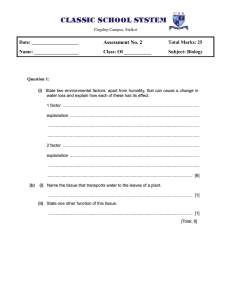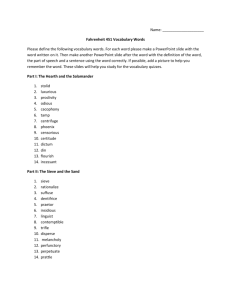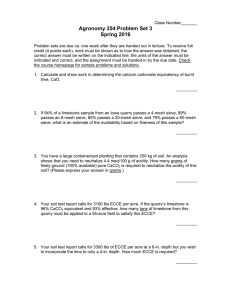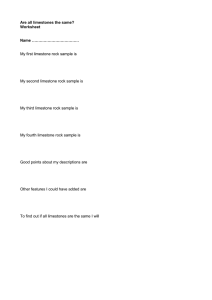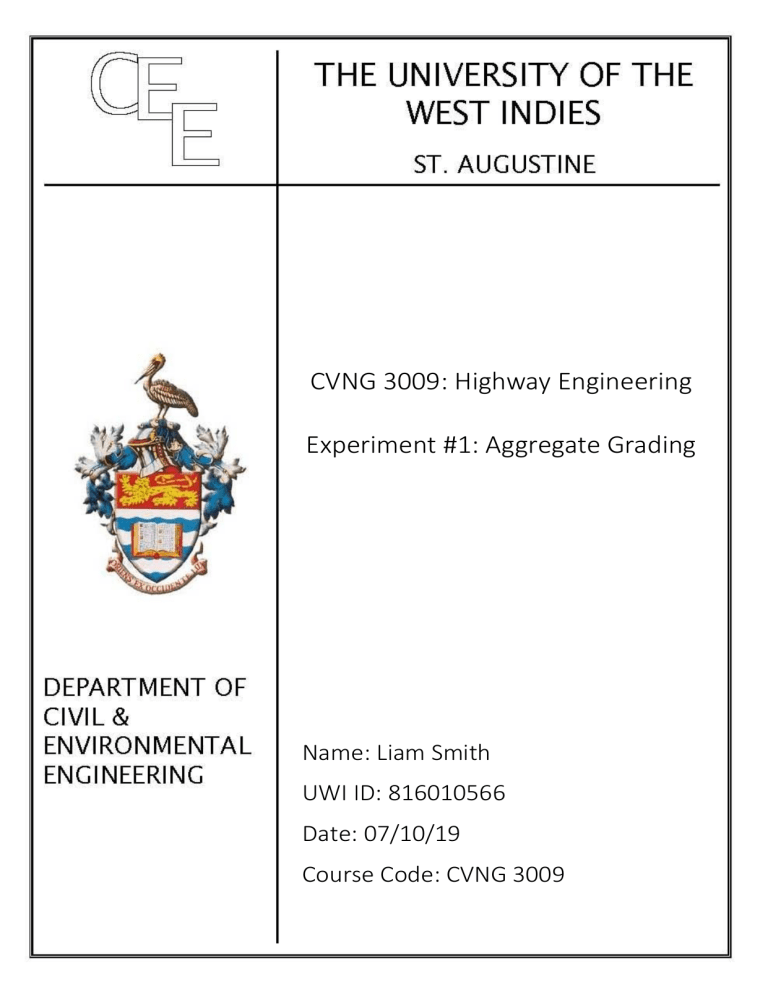
CVNG 3009: Highway Engineering Experiment #1: Aggregate Grading Name: Liam Smith UWI ID: 816010566 Date: 07/10/19 Course Code: CVNG 3009 1|Page Table of Contents Abstract ................................................................................................................................................... 1 Introduction ............................................................................................................................................ 2 Aim .......................................................................................................................................................... 4 Objectives ............................................................................................................................................... 4 Apparatus & Materials ............................................................................................................................ 4 Procedure................................................................................................................................................ 5 Results ..................................................................................................................................................... 6 Sample Calculations .............................................................................................................................. 12 Discussion.............................................................................................................................................. 14 Limitations ............................................................................................................................................ 15 Sources of Error .................................................................................................................................... 15 Precautions ........................................................................................................................................... 16 Conclusion ............................................................................................................................................. 16 References ............................................................................................................................................ 17 2|Page Abstract This lab report addresses and discusses the fundamentals of HMA mix design for a road pavement. This involves the blending of different aggregates being tested and analysed for the mix design. The gradation of each aggregate is included and a grain size analysis for the aggregate samples tested. A trial and error procedure was employed to achieve an optimum mix design to produce a blend of aggregates of specified grading. The mix design proportions were determined to be: • 1/2” Limestone – 20% • 3/8” Limestone – 25% • Limestone Dust – 30% • Sharp Sand – 25% 1|Page Introduction The materials used in the design of Hot Mix Asphalt (HMA) consists of a combination of two or more aggregates mixed at an appropriate ratio to obtain necessary the gradation requirements. This combination is determined by executing a gradation test, producing the particle size distribution which can be used in production of the asphalt concrete mixture. This is known as the job-mix formula which consists of two parts: 1. The Combined Gradation of the aggregates to be used to produce a satisfactory mix meeting all specification requirements. 2. The Asphalt Content which is necessary to produce a satisfactory mix meeting all the specification requirements. The gradation of the aggregates used in the final mixture can affect its volumetric properties such as stability and workability. Stability being the maximum load that can be sustained and workability being the ease of forming the mix. The particle distribution will affect the density of the mix and as a result, the volume of voids in the mineral aggregate. An excessive volume of voids is undesirable in the mixture neither is too dense of a mix as some void volume is needed to facilitate the application of binder. Figure 1. Showing a close-up of HMA and volumetric properties. (https://www.pavementinteractive.org) Hence, a mathematical trial and error method is applied to obtain acceptable design mix percentages for each aggregate. These percentages must fall within the range of the two limit curves in the Percent Passing vs. log (Sieve Size) graph. The maximum density is not usually applied in the 2|Page field. However, it provides a good reference point for sieve analysis. The Fuller and Thompson equation defines this maximum density such that a graphical plot can be generated. Given by the equation: 𝑑 𝑛 𝑃 = ( ) ∗ 100 𝐷 Where; P = Percent passing a sieve size D = maximum aggregate size d = aggregate size being considered n = parameter which adjusts curve for fineness or coarseness (for maximum particle density n = 0.45 according to Fuller and Thompson) The gradation type for a mixture will be found when comparing the percent passing curve and 0.45 power curve for a given maximum aggregate size regardless of density, uniformity openness or gap grading. Generally, a dense gradation is used for HMA mixtures, which is very compact and varies near to the 0.45 power curve which is the straight-line graph amongst the gap, dense, open and uniform curves shown below. Gap 0.45 Power curve Uniform Dense Open Figure 2. Showing the curves representing various gradation characteristics (https://www.pavementinteractive.org) 3|Page Aim The aim of this lab is to educate students on the importance of gradation testing via first-hand laboratory execution. Also, by allowing them to select their own design mix chosen by mathematical trial and error procedure. Objectives • To perform a sieve analysis on four different aggregates. • To determine the gradation requirements for bituminous concrete • To determine the mix blend for a dense mix asphalt via trial and error procedure. Apparatus & Materials • Electronic Balance. • Aggregates: 1/2” limestone, 3/8” limestone, limestone dust & sharp sand. • Tap water. • Sieves: ¾”, ½”, 3/8”, No. 4, No. 8, No.30, No.50, No.100, No. 200 & Pan. • Mechanical sieve shaker. • Oven. • Bronze brush. • Hand brush. • Spatula. • Large pans required for drying and handling sample. • Bowls for weighing. • Heat resistant gloves. • Fan. • Scoop. • Ear plugs. 4|Page Procedure 1. A portion of the aggregates was taken from the bin and weighed to approximately 1000g on the electric balance using a scoop and a metal bowl. 2. The aggregates were then rinsed under the tap through a No. 200 sieve to remove clay and silt form the aggregate and was transferred to the large pan for heating in the oven. 3. Samples were checked every so often and the spatula was used to stir the aggregate in the pan. 4. When the aggregates were sufficiently dried, the pan was removed from the oven and placed to cool in front of a fan 5. Once the samples were cooled, the sieves were placed in order of decreasing size from top to bottom. 6. The aggregates were poured into the stack and manually shaken. 7. The stack was covered and placed in the mechanical sieve shaker which was turned on for approximately 3 minutes. 8. The sieve stack was then taken apart and the amount of aggregates left on each size was weighed and the cumulative weight retained was recorded. 9. The cumulative weight, percentage retained and the percentage passing on each sieve size was recorded and tabulated. 10. A graph was plotted for the percent passing against sieve size. 11. In order to get a final mix design, a mathematical trial and error procedure was utilized (Microsoft Excel) such that an optimum mix would fall within the target values. 5|Page Results Sample Description 1/2" Limestone Quantity (g) 1000 Standard (mm) Alternate Cumm. Weight Retained (g) Cumm. Percentage Retained (%) Percent Passing (%) 25 1" 0 0 100 19 3/4" 0 0 100 12.5 1/2" 599 59.9 40.1 9.5 3/8" 932 93.2 6.8 4.75 4 995 99.5 0.5 2.36 8 995 99.5 0.5 0.6 30 995 99.5 0.5 0.3 50 995 99.5 0.5 0.15 100 995 99.5 0.5 0.075 200 995 99.5 Table 1. Showing Sieve Analysis Data for 1/2” Limestone. 0.5 Gradation of 1/2" Limestone 120 Percent Passing (%) 100 80 60 40 20 0 0.01 0.1 1 10 100 Sieve Size (mm) Graph 1. Showing the Gradation of 1/2" Limestone. 6|Page Sample Description 3/8" Limestone Quantity (g) 1000 Standard (mm) Alternate Cumm. Weight Retained (g) Cumm. Percentage Retained (%) Percent Passing (%) 25 1" 0 0 100 19 3/4" 0 0 100 12.5 1/2" 0 0 100 9.5 3/8" 81 8.1 91.9 4.75 4 916 91.6 8.4 2.36 8 986 98.6 1.4 0.6 30 986 98.6 1.4 0.3 50 986 98.6 1.4 0.15 100 986 98.6 1.4 0.075 200 988 98.8 Table 2. Showing Sieve Analysis Data for 3/8” Limestone. 1.2 Gradation of 3/8" Limestone 120 Percent Passing (%) 100 80 60 40 20 0 0.01 0.1 1 10 100 Sieve Size (mm) Graph 2. Showing the Gradation of 3/8” Limestone. 7|Page Sample Description Limestone Dust Quantity (g) 1000 Standard (mm) Alternate Cumm. Weight Retained (g) Cumm. Percentage Retained (%) Percent Passing (%) 25 1" 0 0 100 19 3/4" 0 0 100 12.5 1/2" 0 0 100 9.5 3/8" 0 0 100 4.75 4 43 4.3 95.7 2.36 8 299 29.9 70.1 0.6 30 582 58.2 41.8 0.3 50 668 66.8 33.2 0.15 100 738 73.8 26.2 0.075 200 813 81.3 Table 3. Showing Sieve Analysis Data for Limestone Dust. 18.7 Gradation of Limestone Dust 120 Percent Passing (%) 100 80 60 40 20 0 0.01 0.1 1 10 100 Sieve Size (mm) Graph 3. Showing the Gradation of Limestone Dust. 8|Page Sample Description Sharp Sand Quantity (g) 1000 Standard (mm) Alternate Cumm. Weight Retained (g) Cumm. Percentage Retained (%) Percent Passing (%) 25 1" 0 0 100 19 3/4" 0 0 100 12.5 1/2" 3 0.3 99.7 9.5 3/8" 3 0.3 99.7 4.75 4 43 4.3 95.7 2.36 8 204 20.4 79.6 0.6 30 471 47.1 52.9 0.3 50 633 63.3 36.7 0.15 100 861 86.1 13.9 200 963 96.3 Table 4. Showing Sieve Analysis Data for Sharp Sand. 3.7 0.075 Gradation of Sharp Sand 120 Percent Passing (%) 100 80 60 40 20 0 0.01 0.1 1 Sieve Size (mm) 10 100 Graph 4. Showing the Gradation of Sharp Sand. 9|Page Blending Data Sheet 1" 3/4" 1/2" 3/8" No. 4 No. 8 No. 30 No. 50 Size (mm) 25.000 19.000 12.500 9.500 4.750 2.360 0.600 0.300 0.150 0.075 1/2" Limestone 100 100 40.1 6.8 0.5 0.5 0.5 0.5 0.5 0.5 3/8" Limestone 100 100 100 91.9 8.4 1.4 1.4 1.4 1.4 1.2 Limestone Dust 100 100 100 100 95.7 70.1 41.8 33.2 26.2 18.7 Sharp Sand 100 100 99.7 99.7 95.7 79.6 52.9 36.7 13.9 3.3 Specs. (lower limit) 100 100 80 70 50 35 18 13 8 4 Mix Design 100 100 87.9 79.3 54.8 41.4 26.2 19.6 11.8 6.8 Specs. (upper limit) 100 100 100 90 70 50 29 23 16 Table 5. Showing the Percentages of all Aggregates in the Mix Design and their Properties. 10 Sieve Aggregate Size Final Mix Design Proportions (%) 1/2" Limestone 20% 3/8" Limestone 25% Limestone Dust 30% Sharp Sand 25% No. 100 No. 200 Total (sum) 100% Table 6. Showing the Proportions Required for the Mix design. Aggregate Original weight (g) Total Cumulative Weight (g) Percentage Loss (%) 1/2" Limestone 1000 995 0.5 3/8" Limestone 1000 988 1.2 Limestone dust 1000 963 3.7 Sharp sand 1000 813 18.7 Table 7. Showing the Percentage of Particles Lost after Washing. 10 | P a g e Combined Gradation of Aggregates (Mix Design) 120 100 Percent Passing (%) 80 60 40 20 0 0.010 0.100 1.000 10.000 100.000 Sieve Size (mm) Specs. (lower limit) Specs. (upper limit) Mix Design Graph 5. Showing the Combined Gradation of Aggregates. 11 | P a g e Sample Calculations Sample calculations for 1/2" Limestone aggregate: • Calculating Percent Mass Lost for validation; Total cumulative weight = 995g Total percent mass lost = 1000−995 x 1000 100 = 0.5% • Calculating Percent Mass Retained; Using No. 100 Sieve Size, Cumulative weight retained = 995 g So, Cumulative Percent Retained = Cumulative Weight Retained x Original Weight of Sample 100 995 = 1000 x 100 = 99.5% • Calculating Percent Passing; Percent Passing = 100% - Cumulative Percent Retained = 100% - 99.5% = 0.5% • Calculating Mix Design Proportions; Using No. 100 Sieve Size, Percent passing sieve size No. 100 from each sample of aggregate: ▪ 1/2“ Limestone – 0.5% ▪ 3/8“ Limestone – 1.4% ▪ Limestone Dust – 26.2% ▪ Sharp Sand – 13.9% 12 | P a g e Mix Design Proportions after trial and error: • • 1/2“ Limestone – 20% • 3/8“ Limestone – 25% • Limestone Dust – 30% • Sharp Sand – 25% Calculating total percentage passing through the No. 100 sieve using the mix design proportions. Total % Passing = (0.5 x 0.20) + (1.4 x 0.25) + (26.4 x 0.30) + (13.9 x 0.25) = 11.85% This percent is acceptable as it falls within the acceptable range for the No. 100 Sieve (8% to 16%) ensuring that specifications are met. Mix designs were found for each sieve and it was ensured that they fell within their respective ranges. These calculations were executed for all aggregates and the respective data. 13 | P a g e Discussion In the execution of this test, an acceptable aggregate grading for an HMA mix design has been selected via trial and error. In so doing gradation tests were utilized as mentioned prior, to meet the design and production requirements as well as the specifications throughout this process. This test also serves to minimize the number of voids within the aggregate mix. In dense-graded mixtures HMA, aggregate accounts for most of the volume in the mix and reflects on the performance of the pavement after use. For the sake of this experiment, 1/2" Limestone, 3/8” Limestone, Limestone Dust and Sharp Sand were the aggregates utilized for the mix design. Which were analyzed and results were recorded and can be further classified based on their sample distribution as either coarse or fine graded depending on passage of sieves. Upon observation of the gradation graphs/particle distribution of each aggregate (Percent Passing vs. Sieve Size), it can be said that 1/2" and 3/8” Limestone were uniformly graded. Whereas, Limestone Dust was observed to be densely graded and Sharp Sand was said to be open/well graded. These grading deductions were made in relation to the graphs in figure 2 in the Introduction above. The particle distribution of the aggregates based on results obtained also shows that: • 1/2" Limestone consisted of 99.5% coarse aggregate whilst 0.5% of the sample’s mass was lost during the experiment. • 3/8” Limestone consisted of 91.6% coarse aggregate and 7% fines whilst 1.4% of the sample’s mass was lost during the experiment. • Limestone Dust consisted of 4.3% coarse aggregate and 77% fines whilst 18.7% of the sample’s mass was lost during the experiment. • Sharp Sand consisted of 4.3% coarse aggregate and 92% fines whilst 3.7% of the sample’s mass was lost during the experiment. In the AASHTO T27 code it states that the allowable percent of aggregate lost should not exceed 0.3% of the sample’s mass. Thus, with reference to the samples used for testing, all failed. This failure is due to high levels of impurities (silt and clay) in the aggregates as well as weighing inaccuracies as the electric balance is of low precision from its digital readings and possible loss during shaking and transferring fractions between the various containers and surfaces. Failure cannot be an option when it comes to creating ideal road surfaces. The creation of a mix design that contains the optimum combination of aggregate (coarse and fines) is facilitated by the trial and error method, mentioned often in this report. This procedure was executed in Microsoft 14 | P a g e Excel, where after all values were inputted it was just a matter of altering the aggregate proportions and distributing them amongst the gradations or sieve sizes passing. The design mix was plotted between the upper and lower limits as given in the lab manual and the proportions were varied until the design mix graph fell within the two limits. An opinion made in deciding when the process should be ended at the most evenly distributed location. The final design mix conformed to the specifications of Type E Wearing Course, falling within the limits as shown in Graph 5, making it acceptable for use in the final design of HMA for the surface course. The mix design obtained for the experiment was: 1/2” Limestone – 20%, 3/8” Limestone – 25%, Limestone Dust – 30%, Sharp Sand – 25% Limitations • The levels of impurities (silt and clay) in the aggregates which all exceeded AASHTO T27 limit of 0.3% lost to the procedures of the experiment. • Sieve analysis assumes that all particles are completely round or spherical so that they will pass through the sieve openings. • Dissolving, erosion, swelling or reactions can occur during the washing process hence resulting in changes in individual aggregate sizing and overall mass of sample. • The determination of material passing through the no. 200 sieve cannot be accurately made. Sources of Error • Precision error in electric balance when measuring aggregates. • Loss of aggregates to the environment when transferring aggregates from different containers and surfaces. • Samples experienced some form of change due to being washed then dried bringing up the possibility of swelling, dissolving, erosion or reactions when in contact with water. • Long term shaking of aggregates in the mechanical sieve shaker can cause degradation of aggregates resulting in loss or gain in fractions of the sieve. • Possibility of aggregates blocking sieve openings preventing some aggregates from passing through. • Aggregates can get lodged in the brushes when brushing sieves. 15 | P a g e Precautions • The aggregates were dried thoroughly before conducting the sieve analysis. • The aggregates were washed until the water flowing out of the No. 200 sieve appeared clear indicating that the sample was washed until clear of silt and clay. • A brush was used to ensure that the sieves were completely free of aggregates when transferring and weighing. • Mittens were worn by the person handling the metal pans in the oven to avoid damages to person. • Students wore earplugs when loud machinery was in operation. • One sieve larger and smaller than the specified sieve sizes were added to the stack for precautionary measures. Conclusion The mix design chosen in compliance with the design requirements and limit range was determined to be: • • • • 1/2” Limestone – 20% 3/8” Limestone – 25% Limestone Dust – 30% Sharp Sand – 25% These proportions were considered the most ideal based on personal opinion/preference. 16 | P a g e References • University of the West Indies, Highway & Transport Laboratory Manual - "Experiment 1Aggregate Grading “Accessed October 1st, 2019. • AASHTO T 27-06, “Standard Test Method for Sieve Analysis of Fine and Coarse Aggregates,” American Association of State Highway and Transportation Officials, Accessed October 7th, 2019. • Pavement interactive. “Gradation Test” Accessed October 3rd , 2019. https://www.pavementinteractive.org/reference-desk/testing/aggregate-tests/gradationtest/ 17 | P a g e
